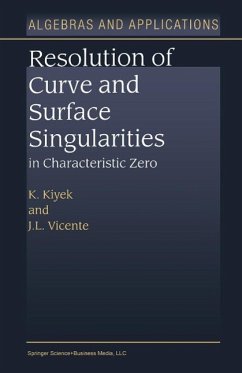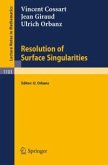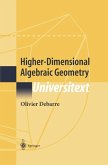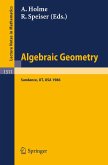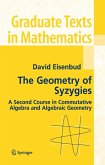The Curves The Point of View of Max Noether Probably the oldest references to the problem of resolution of singularities are found in Max Noether's works on plane curves [cf. [148], [149]]. And probably the origin of the problem was to have a formula to compute the genus of a plane curve. The genus is the most useful birational invariant of a curve in classical projective geometry. It was long known that, for a plane curve of degree n having l m ordinary singular points with respective multiplicities ri, i E {1, . . . , m}, the genus p of the curve is given by the formula = (n - l)(n - 2) _ ~ "r. (r. _ 1) P 2 2 L. . ,. .. . Of course, the problem now arises: how to compute the genus of a plane curve having some non-ordinary singularities. This leads to the natural question: can we birationally transform any (singular) plane curve into another one having only ordinary singularities? The answer is positive. Let us give a flavor (without proofs) 2 on how Noether did it . To solve the problem, it is enough to consider a special kind of Cremona trans formations, namely quadratic transformations of the projective plane. Let ~ be a linear system of conics with three non-collinear base points r = {Ao, AI, A }, 2 and take a projective frame of the type {Ao, AI, A ; U}.
Dieser Download kann aus rechtlichen Gründen nur mit Rechnungsadresse in A, B, BG, CY, CZ, D, DK, EW, E, FIN, F, GR, HR, H, IRL, I, LT, L, LR, M, NL, PL, P, R, S, SLO, SK ausgeliefert werden.
From the reviews:
"As indicated in the title ... describes different methods of resolution of singularities of curves and surfaces ... . The first seven chapters are dedicated to developing the material ... . The two appendixes, on algebraic geometry and commutative algebra, contain generalities and classical results needed in the previous chapters. This completes one of the aims of the authors: To write a book as self-contained as possible. ... In conclusion, the book is an interesting exposition of resolution of singularities in low dimensions ... ." (Ana Bravo, Mathematical Reviews, 2005e)
"The monograph presents a modern theory of resolution of isolated singularities of algebraic curves and surfaces over algebraically closed fields of characteristic zero. ... The exposition is self-contained and is supplied by an appendix, covering some classical algebraic geometry and commutative algebra." (Eugenii I. Shustin, Zentralblatt MATH, Vol. 1069 (20), 2005)
"As indicated in the title ... describes different methods of resolution of singularities of curves and surfaces ... . The first seven chapters are dedicated to developing the material ... . The two appendixes, on algebraic geometry and commutative algebra, contain generalities and classical results needed in the previous chapters. This completes one of the aims of the authors: To write a book as self-contained as possible. ... In conclusion, the book is an interesting exposition of resolution of singularities in low dimensions ... ." (Ana Bravo, Mathematical Reviews, 2005e)
"The monograph presents a modern theory of resolution of isolated singularities of algebraic curves and surfaces over algebraically closed fields of characteristic zero. ... The exposition is self-contained and is supplied by an appendix, covering some classical algebraic geometry and commutative algebra." (Eugenii I. Shustin, Zentralblatt MATH, Vol. 1069 (20), 2005)

